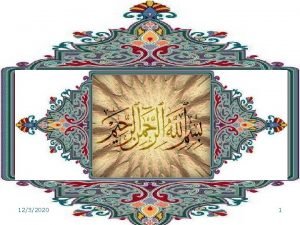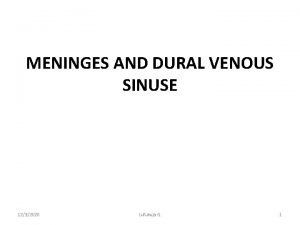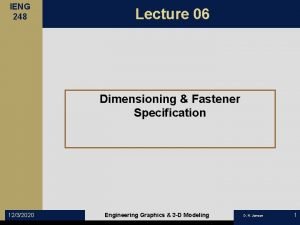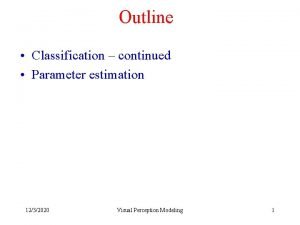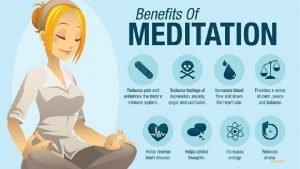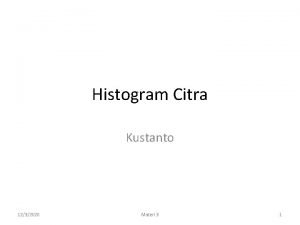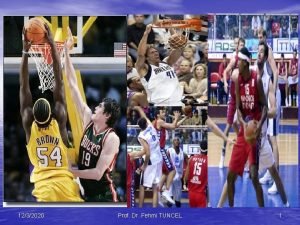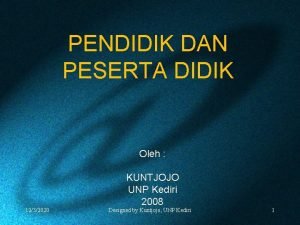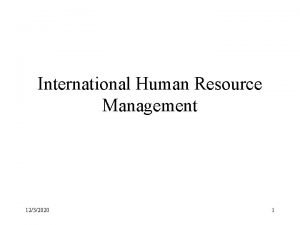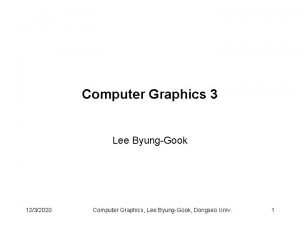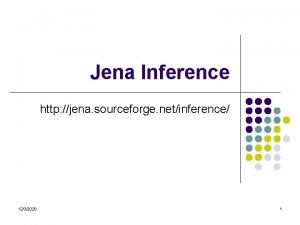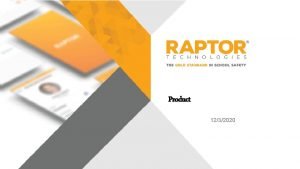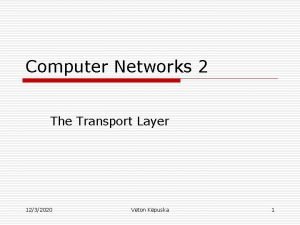1232020 1 1232020 2 1232020 3 1232020 4






































- Slides: 38

12/3/2020 1

12/3/2020 2

12/3/2020 3

12/3/2020 4

Definition Spinal traction means drawing or pulling on the spinal column (vertebral column). 12/3/2020 5

Effects of Spinal Traction 1. Mechanical elongation of spine (mechanical separation of vertebrae → widens the intervertebral foramina). 2. Zygopophyseal (facet) joint mobilization. 3. Muscle relaxation greater vertebral separation → relaxation →↓ pain from m. spasm or guarding 4. Reduction of pain. 12/3/2020 6

12/3/2020 7

• Factors influencing amount of vertebral separation a) Spinal position. - Flex → post aspect separation of vertebrae. b) Amount of force. - 7% body wt for cervical traction. - 50% body wt for lumbar traction. c) Comfort & relaxation. - → greatest vertebral separation. D) Angle of pull. - In cervical flex 35°→ greatest post. separation. - In lumbar, harness pull from the post aspect pelvis rather than from the sides → spine flexion. 12/3/2020 8

• Traction → 1. Compress, or 2. Approximate, 3. Slide, or 4. Translate facet surfaces. • Factors influencing direction of facet surfaces mov. : 1. Flexion & longitudinal traction→ slide facet surfaces. 2. Side bending of spine → slide facet surfaces on convex side. Adding longitudinal traction → stretch facet surfaces on concave side. 3. Rotation of spine → distract facet surfaces on the side toward which the body of the superior vertebra is rotating & compress on the opposite side. 12/3/2020 9

12/3/2020 10

• Factors influencing amount of relaxation: a. Pt. position: To feel secure & well supported, many pts reported feeling more relaxed in supine than sitting for cervical traction. b. Duration of traction: 20 -25 mins traction is necessary for m. relaxation. c. Force: M. relaxation can be achieved for cervical spine. by mechanical separation (only 4. 5 : 6. 5 kg max. ). d. Spinal position: A lesser angle of pull → greater relaxation. 12/3/2020 11

A. Mechanical effects: • Movement →↑ circulation →↓ concentration of noxious chemical irritants. • Vertebral separation → temporary ↑ intervertebral foramina size, which →↓ pressure on impinged nerve root. B. Neurophysiologic effects: 1. Mechanoreceptor stimulation → block nociceptive stimuli transmission at spinal cord or brain stem level. 2. Inhibition of reflex m. guarding →↓ discomfort from contracting ms. 12/3/2020 12

Factors Influencing Amount of Pain Reduction 1. 2. 1. Patient position. The patient should be positioned for comfort & ease of application. Spinal position. A. Acute stage: Usually the involved spinal segment is positioned in a (slack) pain free position. B. Subacute & chronic stage: Usually the involved spinal segment is positioned in a stretched position. Force & duration. A. Acute stage: Only use low intensity oscillations (no stretch) for a short period. B. Subacute & chronic stage: Progressively ↑ amount o force & duration depending on patient tolerance. 12/3/2020 13

Types of application of traction 1. Constant (static): A steady force is applied & maintained for an extended time. A. Continuous (prolonged): - A static force is maintained for several hours or days Often it is applied in bed, small amount of wt. is tolerated. Usually for immobilization. (mechanical) B. Sustained: - A static traction in which the force is maintained from a few minutes up to one-half hour. (manua or mech. ) - It is useful as a prolonged stretch to spinal structures. 1. Intermittent: - The force is alternately applied & released at frequent intervals, with greater forces than sustained traction. 12/3/2020 - Usually in a rhythmic pattern. (preferred mech. ) 14

Modes of application 1. Mechanical Various types of equipments are available for hospital, clinic or home use. (objective way) 2. Manual Through positioning & handling, the PT applies traction force to the desired spinal segment. 3. Positional Through positioning, a sustained force on specific segment of spinal column can be obtained. 12/3/2020 15

Indications 1. Spinal nerve root impingement from: A. herniated nucleous pulposus. B. spinal or foraminal stenosis caused by spondylosis, edema & spondylolisthesis. 1. Joint hypomobility due to: A. dysfunction B. degenerative changes. 2. Symptomatic facet joints pain. 3. M. spasm. 4. Diskogenic pain & Post-compression #. 12/3/2020 16

Contraindications 1. Acute strains, sprains & inflammations aggravated by initial traction ttt. 2. Rheumatoid arthritis of cervical spine where necrosis of supporting ligs → instability & subluxation or dislocation of a vertebra with spinal cord damage. 3. Any spinal condition or disease in which movement is contra-indicated. (TB) 12/3/2020 17

Precautions 1. Osteoporosis. 2. Patients using dentures shouldn’t remove it as →TMJ is forced into an abnormal resting pos. & can be traumatized with pressure from the chinstrap. 3. Patients with respiratory problems. 4. TMJ pain may be provoked with using cervical halter, especially when the chinstrap places a lot of force on the mandible, so manual traction can be applied in this case. 12/3/2020 18

General procedures 1. Determine appropriateness for choice of traction by testing with manual traction at first. - If the traction test relieved or reduced the symptoms, an initial ttt is given. - If the traction test aggravates the symptoms, traction ttt should probably not applied. 2. Determine if manual, positional or mechanical traction will be used. 12/3/2020 19

3. Position the pt for max comfort & relaxation. 4. Determine duration of traction. 5. Apply safety roles for mechanical traction. – Use ropes that are in good repair. – Secure the equipment so it will n’t move when the traction force is applied. - Check the poundage dial is turned to zero before & after ttt. - Periodically check the poundage calibration. - Use disposable tissues, gauze & halters. – Never leave the pt. alone while receiving traction unless he/she has some means to signal for help. 12/3/2020 20

Cervical traction techniques I. Manual traction: 1. Position of pt: supine, relaxed as possible on ttt table. 2. Position of PT: stand at head of ttt table, support wt of pt head in his hands. 3. PT hand placement. 12/3/2020 21

12/3/2020 22

Hand placement depends on comfort. Either: - place both hands fingers under the occiput. - place one hand over frontal region & other hand under occiput. - place index fingers around spinous process above the vertebra to be moved. This hand placement provides a specific traction to the vertebral segments below the level where fingers are placed. A belt around the PT hips can be used to reinforce the fingers & ↑ ease of traction force application. 12/3/2020 23

3. When manual traction is used for evaluation, vary the pt’s head pos in flex, ext, side bending with rotation & apply a traction in each pos & - note the pt’s response. 4. When administering ttt, use the pos that most effectively ↓ or relieves - - symptoms. 5. The PT applies the force by fixing his arms isometrically, assuming a stable stance & then leaning backwards in a controlled manner. - If a belt is used → the force is transmitted through the belt. 12/3/2020 24

6. The force is usually applied intermittently, with a smooth gradual building & releasing of the traction force. The intensity & duration are usually limited by the PT strength & endurance 7. Value of manual traction a. Angle of pull & head pos. can be controlled by the PT. b. By placing the index fingers around specific spinous processes, the level of traction can be controlled to some degree. c. No stress is applied on the TMJ as is frequently done in mechanical traction. 12/3/2020 25

II. Mechanical traction: 1. Review the manufacturer’s directions of the machine to become familiar with the available traction unit. 2. Position the pt. for comfort: A. Sitting - Uses less clinical space but requires more force to overcome m tension & obtain greater separation than supine lying. - Use a comfortable chair with arm rests or place a pillow on the pt’s lap for the arms to rest on. - Chair height should support the thighs & allow the feet to rest comfortably on the floor or on a foot stool. B. Supine - Requires less force to overcome m. tension than sitting. - Tends to ↓ lordotic curve by the force of gravity on vertebrae. - Support the pt. with pillows for max. comfort. c. semi-reclining 12/3/2020 26

12/3/2020 27

3. Position of patient head is determined by evaluation as well as the condition being treated. – To obtain post. separation of the vertebrae, the head should be positioned in flexion up to 35°. - To obtain greater m relaxation, position the head closer to neutral. 4. Apply the head halter. – First, line the head halter with gauze or tissue. – Adjust the halter to fit the chin to The major fit the pt comfortably. traction force must be against the occiput not the chin, to ↓ compression of TMJ. Gauze may be placed between the teeth or padding under the chin to absorb pressure. Don’t remove dentures if the pt wears them as stress may be placed on TMJs. Eye glasses should be safely set aside. 12/3/2020 28

5. Attach the halter to the spreader bar of the unit; check that the pt is aligned for proper pull. traction 6. Set controls: - The poundage dial should be set at zero before activating the unit. - If the unit has off-on timer for intermittent traction, suggested starting intervals are 30 seconds on, 30 secs off, or 1 min on, 30 secs off. 7. Activate the unit & gradually ↑ traction force: - To avoid ttt soreness the 1 st ttt poundage shouldn’t exceed 10 -15 pounds. - Progression of dosage at succeeding ttts will depend on the goals & pt’s reaction. 8. Treatment duration: - May be from 10 -30 mins for sustained or intermittent traction, depending on the pt’s condition & ttt goals. 12/3/2020 29

9. Demonstrate to the pt how to turn off the unit - if his symptoms get worse. 10. At the end of the ttt: - Turn all controls off & turn dial indicators to zero. - Remove the halter from the spreader bar. Then remove the head halter. 11. Re-evaluate the pt’s condition: - Be sure he doesn’t feel dizzy or before leaving the ttt area. 12. If the pt complains of headache, nausea, fainting or ↑ symptoms during or following ttt: - Reduce the wt or length of ttt time at the next visit or discontinue ttt. 12/3/2020 30

Lumbar traction techniques I. Manual traction: 1. It isn’t easy as in cervical region because at least ½ body wt. must be moved & coefficient of friction of the part to be moved must be overcome. 2. Pt. position: supine on ttt table. 3. PT position: varies with pos of pt hips & LL – With the LL extended & lumbar in extension, the PT can exert a pull at the ankles. – With the hips flexed 9 o° & lumbar spine flexed, the pt’s legs are draped over PT’s shoulders. The PT then exerts the force with his/her arms wrapped across the pt’s thighs 12/3/2020 31

4. When manual traction is used for evaluation: - Vary the amount of flex, ext & side bending & note the pt’s response. 5. During ttt: - Use spinal pos. that best ↓ the S&S. 6. PT must use his entire body wt to ↑ effect of traction force: - Place the pt on a split traction table to ↓ friction. - When applying a high-dosage traction force, the thorax is stabilized. Put a counter-traction belt around pt’s rib cage & secure it to the head end of the table, or have a second person to stabilize the pt by standing at the head end of table & holding onto pt’s arms. 12/3/2020 32

II. Mechanical traction 1. Be familiar with the unit available by reviewing the manufacturer’s operating instructions. The most effective traction is applied via a split-traction table, as eliminating the need to overcome the coefficient of friction of half of the body’s wt. 2. Apply traction & counter-traction harness (belt): - traction harness is applied over the skin above pelvis → upper part is secured above the iliac crest. - counter traction harness is attached around lower rib cage → keep pt. from slipping. 12/3/2020 33

12/3/2020 34

3. Position the pt either supine or prone: - Thorax should be on the stationary part of the table & pelvis on the movable one so; lumbar spine is positioned over the split of the table. - Whether the spine in flex or ext is determined by evaluation, pt’s comfort & the condition as well as ttt goal. - To obtain posterior separation of the vertebrae, the lumbar spine should be flexed (flattened): a. when supine, hips are flexed & thighs rest on a padded stool. b. when prone, several pillows are placed under the pt’s abdomen. 12/3/2020 35

4. Attach the anchor straps: a. The counter-traction or stabilizing harness is secured to the end of the traction table. b. The straps from traction harness may attach to a spreader bar attached to the traction rope. If unilateral traction, one anchor only’ll be attached to traction rope. c. Check that the pt. is aligned for proper pull & then take all the slack out of the straps. 5. Set the controls a. Be familiar with the type of unit. b. If the unit has off-on timers for intermittent traction, set them for the desired time intervals. c. Set ttt duration. It may be up to 30 mins for most units. It depends on the goals, pt’s condition & reaction to traction. 12/3/2020 36

6. Unlock the split traction table - so it will separate when the unit is activated. 7. Activate the unit & gradually ↑ the force (if the unit hasn’t been pre-programmed to do so automatically). 8. Demonstrate to the pt how to turn off the unit - if his symptoms worsen while the unit is on. Make sure he has a signaling device to call for help if necessary. 9. At the end of the ttt: a. Turn all controls off & turn indicators back to zero. b. Lock the split on the table before the pt attempts to get off. c. Re-evaluate the pt; note any changes in S, S & ROM. 12/3/2020 37

Home & Positional Traction 12/3/2020 38
